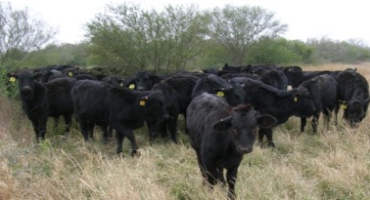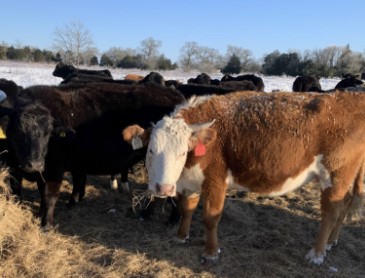By Kay Ledbetter
The ice has disappeared and pastures are drying, but cattle producers should not consider Winter Storm Uri something of the past. Livestock should continue to be watched as the weather warms, according to Texas A&M AgriLife Extension Service experts.

Frost starts to gather on the backs of a cattle herd near Corpus Christi.
“Like most livestock operators, I worried about my cattle and young calves in this weather,” said Joe Paschal, Ph.D., AgriLife Extension livestock specialist, Corpus Christi. “I did not think that it was going to get as bad as it did. I wrapped pipes, turned on heat lamps and let troughs run over. I put out extra bales of hay and moved things around in the barn to allow the cattle to get in out of any rain and wind. I was not even thinking of snow or ice.”
Paschal said many livestock owners took similar actions and made it through the frigid temperatures and icy conditions. But he warned livestock producers the coast is not clear just because the ice is gone.
Latent effects to watch for in livestock
Ted McCollum, Ph.D., retired AgriLife Extension beef cattle specialist, Amarillo, came up with a list of “latent effects” after a blizzard hit the Texas Panhandle in late 2015. Similarly, Paschal said, the 2021 weeklong freezing temperatures and wind chill could have latent effects or an especially long-lasting impact on livestock.

Extra hay was put out for cattle that were seeing snow for the first time in their lives.
Tails, ears and even cows’ teats and udders and bulls’ prepuces, sheaths and scrotums could be frostbitten, causing some partial loss or loss of function in the next few weeks. Look for raw or bleeding skin or scabbed over areas. Veterinary treatment should be considered, especially for frostbitten prepuces, to prevent infection. While these are not long-term threats to the animal’s well-being, they could affect reproductive function.
Cows with frostbitten udders or frozen teats may be sensitive, reducing milk production and consumption by their calves for a few days. Unless infection ensues or the udder or teats are severely damaged, there may be only some mastitis and partial loss of udder function. Cows calving this spring could also be affected, but it would not be noticeable until they calve and begin lactating, so they should be evaluated then as well.
Lost reproduction
Short-bred heifers and cows may abort their fetuses as a result of the stress, and long-bred cows can abort calves that were nearly term. This is especially true, but not limited to, high percentage Bos indicus or Brahman-type, cattle, said Corrie Bowen, AgriLife Extension agriculture and natural resources agent, Wharton County.
This hard freeze hit late in the winter during the beginning of calving season in many areas of Texas. In the past, freezes like this occurred in December when cows were still heavy bred. This is what made this hard freeze different and so deadly to calves, Bowen said.
Early abortions have been reported as a result of the weather by Ky Pohler, Ph.D., reproductive physiologist for the Texas A&M Department of Animal Science. Pohler detected early embryonic losses using ultrasound in a research herd in College Station.
Pohler said Texas cattle that do not typically experience this type of weather and are adapted to tropical and subtropical climates. Additionally, these cattle went from grazing winter forage and early spring forage to either eating hay free choice or receiving some other type of supplement. This major shift in nutritional sources and the additional stress from the weather could have had a negative impact.
He said he would anticipate seeing slightly higher pregnancy loss in cattle that were between seven and 45 days of gestation during this weather event. It is not something that will be a complete reproductive failure, but something to keep an eye on.
Bull soundness
Prepuces and scrotums of bulls exposed to freezing temperatures and wind chills might be frostbitten, especially bulls with slightly larger sheaths and prepuces. Bulls being used now or considered for use should have a breeding soundness examination, BSE, performed on them. Semen production is a long-term process and fertility could be impacted for one or two months.
Bulls for breeding in fall calving herds should have a BSE performed as soon as possible to check for injury and semen quality to ensure a high percent calf crop. Cows in fall calving herds that are not bred could have delayed estrus and pregnancy, resulting in late calves. Estrus activity should return to normal in a few weeks if there are no other injuries.
Stress and disease
Cattle and other livestock that survived the extremely frigid temperatures for days are physically very stressed, even those that were adequately supplemented and sheltered. Producers should monitor their herd’s body condition scores and possibly increase supplemental feeding for the remainder of breeding season with fall calving cows or calving for spring calving cows.
Tom Hairgrove, DVM, Ph.D., AgriLife Extension cattle veterinary specialist, Bryan-College Station, said young cows and calves fed and kept up near wet hay or bedding could contract coccidiosis. Look for bloody or black scours in stressed calves. He said that internal parasites could also be an issue in stressed cattle.
Hairgrove also emphasized that stressed cattle are more susceptible to increases in internal parasite infestations, such as stomach worms. Cattle looking thin, anemic and perhaps scouring could be suffering from increased parasitism.
“Observe your livestock closely for other signs that, even though they survived the weather, might indicate something is just not quite right. Chances are that many effects from the week-long hard freeze will be seen for several weeks so be looking for signs of illness or poor doing cattle or calves,” Paschal said. “After all, that’s just good animal husbandry.”
Source : tamu.edu